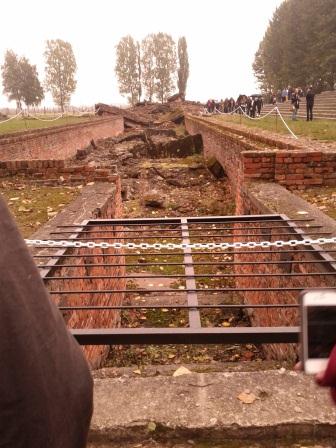
The “Lessons From Auschwitz” project is a government funded educational trip that aims to educate two pupils, from most schools across the UK, about the horrors that occurred during the holocaust. The project consists of 4 stages: The opening seminar (what to expect), the one day trip to Poland, the follow up seminar, and then completing the “next steps” for the LFA project. During the open seminar we had the opportunity to meet and listen to Kitty Hart Moxon, a Jewish Auschwitz survivor. We were struck by her to-the-point attitude towards the horrific ordeal she suffered. We were very thankful to her for sharing her story with us.
The next stage of our journey began at Three o’clock in the morning, with an early morning drive to Edinburgh airport, with a 3 hour flight to Krakow airport to follow. It was then a one hour bus journey to Oswiecim (Polish spelling of Auschwitz). On the way we thought mainly on what we would experience in Poland. The first stop we made in Poland was at a Jewish cemetery in Oswiecim . The cemetery had been destroyed by the Nazi’s in World War 2, however it was restored after the war by two Jewish survivors who made a memorial out of broken bits of gravestone, and re-erected the remaining gravestones. From here it was a 10 minute bus ride to Auschwitz I, which is now a museum. The large numbers of people visiting create a tourist like atmosphere, which undoubtedly dampens the effect of the surroundings. The exhibitions on show made up for this though, as they were as shocking as they were vast. For example the exhibitions of victims hair, shoes, and suitcases were all on display. The most heart-wrenching, and truly sickening part of the trip was walking through a gas chamber and crematorium at Auschwitz I. To walk through this hellish structure where so many were brutally and mercilessly murdered, is an experience beyond explanation.
On the way out of Auschwitz I, we saw the famous gates, which reads “Arbeit macht frei”, meaning “work will set you free”. The prisoners saw this gate every day, coming in and out of work, often carrying their friends dead bodies, killed by the exertions of labour. The irony of the message on the gate is striking, and must have seemed like a sick joke to the prisoners. From Auschwitz I it’s a 2 minute journey to Auschwitz II – Birkeneau – our last stop. The sheer scale of the death camp (400+ acres) was incredible, and to think that the camp was still expanding is beyond belief. We visited the bed houses where prisoners stayed. Some of these were old horse stables, built for 52 horses; The Nazis had over 400 prisoners in a single stable. It is difficult to comprehend the conditions they suffered – we were freezing, in mid September, with several layers on. We then walked down the train tracks that cut through the centre of the camp to the third and fourth gas chambers. The Nazi’s had destroyed these so they couldn’t be used as evidence. We were also shown around a large pits where victims ashes had been dumped. The grass and foliage grows greener in these pits than anywhere else on site.
Once our tours finished, all 200 students gathered at the memorial building where the victims pictures are on display, to show a happy time in their lives – our final memory of them. Everyone then congregated at a memorial at the top of the camp. Here we were part of a memorial ceremony carried out by rabbi Marcus, which was very poignant. It was especially powerful when the rabbi sung in Hebrew, in this bleak place of Nazi oppression.
Looking back now we understand that it is impossible comprehend the sheer brutality of what happened at Auschwitz, and the holocaust in general. The project has highlighted to us the need to re-humanise the victims AND perpetrators. Each victim had a family, a life, people who loved them. They are not a collective number or statistic, but individuals who deserve to be remembered. The perpetrators were also people, normal individual people who carried out these brutal acts on fellow humans. If you ever have the chance to visit Auschwitz, take that chance. You probably wont enjoy it, I cant imagine anyone does, but it is an experience that will open your eyes and change your perspective: Lest we forget.
Sebastian Currie and Abbie Scrimgeour









